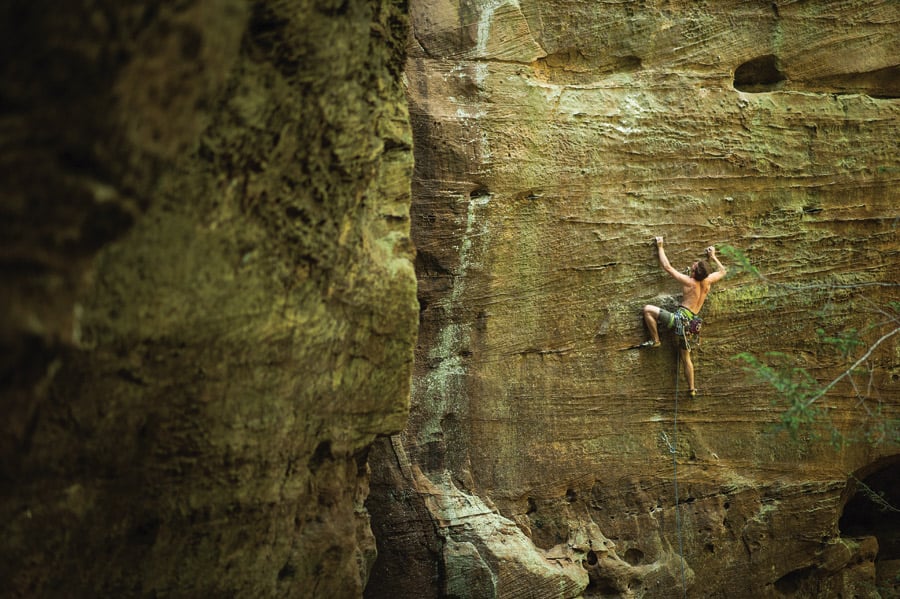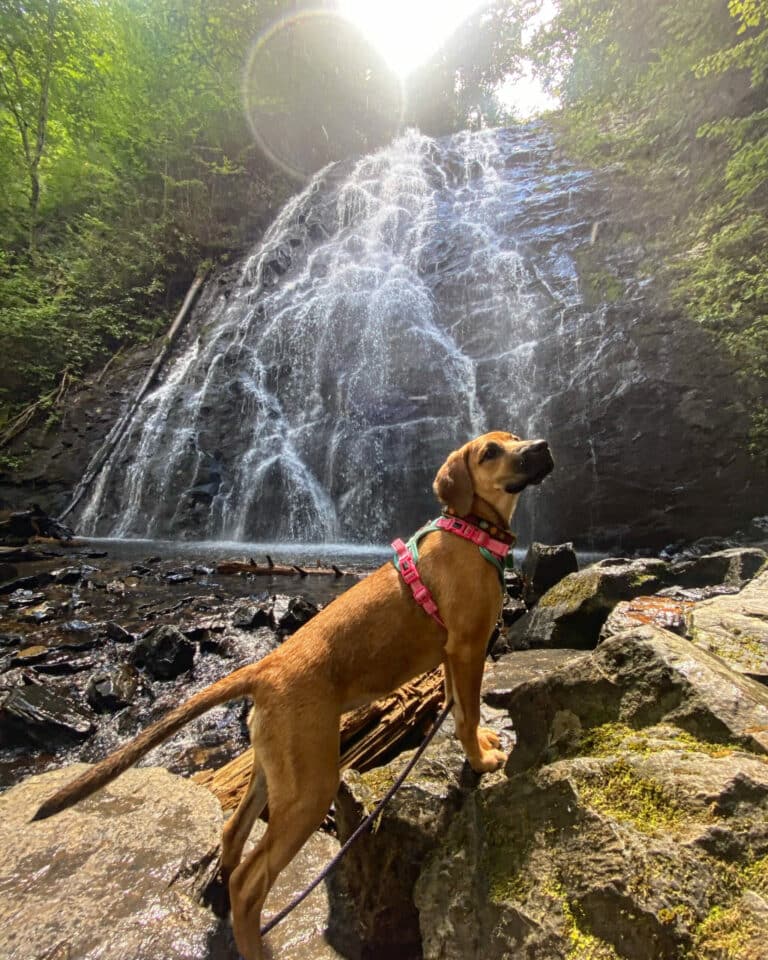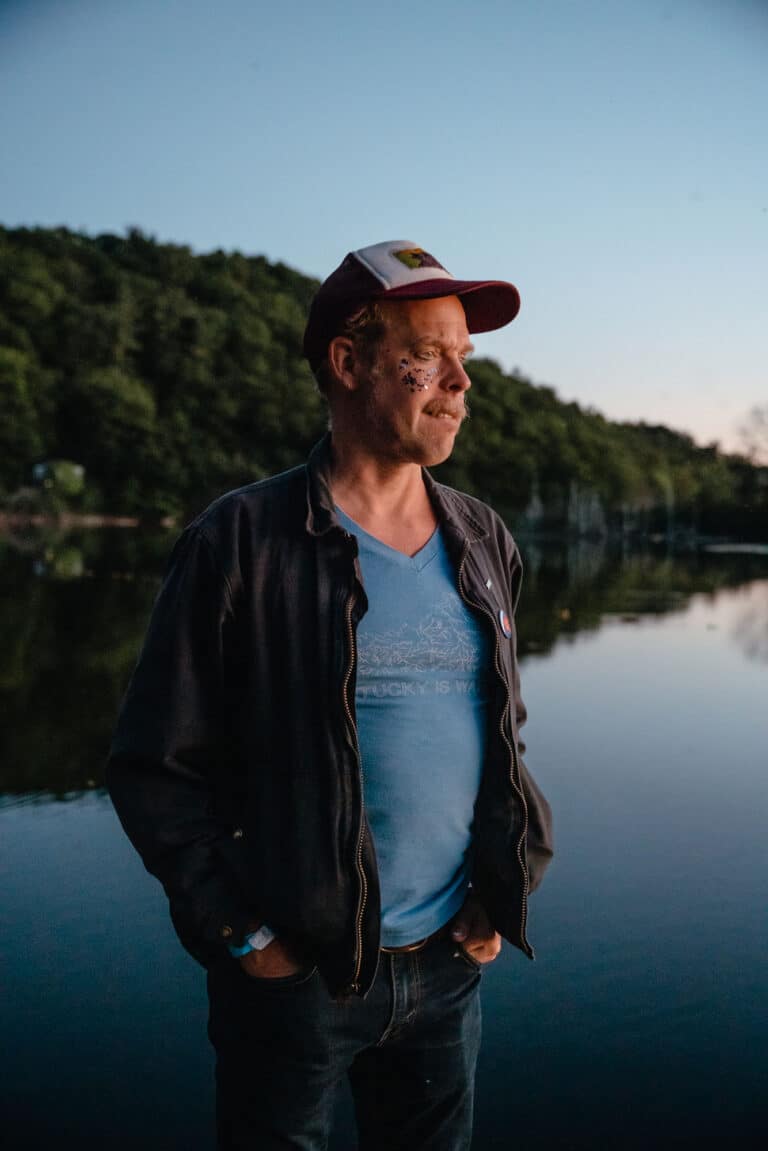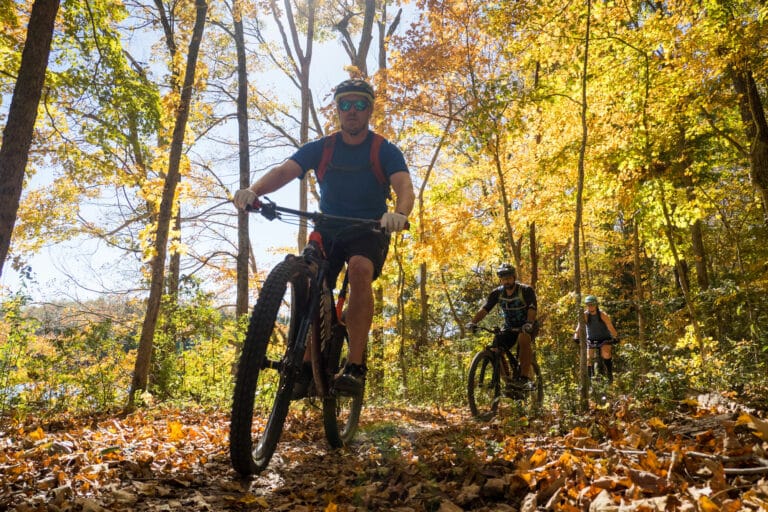The mountains of eastern Kentucky are unlike anywhere in the world. Vast forests of beech, white pine, and hemlock shelter thousands of miles of Corbin Sandstone cliffs and patches of delicate wildflowers. An expanse of deep-green ridgelines rides endlessly toward the horizon, broken only by the valleys that form from the meandering rivers and streams. It’s a magical place, an untamed frontier that once enchanted the early American pioneer Daniel Boone so much so that he moved his family there even after surviving captivity and witnessing his fellow countrymen perish at the hands of local Native Americans.
At the heart of that rugged wilderness lies one of the most revered and iconic climbing destinations in the world: the Red River Gorge. Stretching for over 29,000 acres through the Cumberland Plateau, the Red River Gorge is known for its unique sandstone cliffs, home to more than 2,500 routes ranging from juggy 5.4s to steep, overhanging 5.14s. Even the strongest climbers in the world have yet to send some of the routes in the Red. With the nearest “town” to this climbing mecca being the unincorporated rural community of Slade (population estimated around 300), visitors to the gorge can expect to see a largely uninhabited portion of eastern Kentucky similar to the wilderness that so captivated Daniel Boone over two centuries ago.
But for an area that attracts world-class climbers and grows in international recognition every year, the relatively short history of climbing in the Red River Gorge is pockmarked with misuse and abuse and battles with oil companies. Although the present-day climbing community in the Red now stands stronger than ever, between impact management, crag access, and project funding, there still remain a number of hurdles for climbers to overcome in order to preserve and conserve these beloved crags.
The Climbing Boom
In 1994, the first sport routes in the Red River Gorge were bolted in the Southern Region. At the time, sport climbing was progressive, edgy, limitless. To an adventurous climber, the Red was like an untapped gold mine; in the Daniel Boone National Forest alone (which makes up just a portion of the Red River Gorge), there are over 3,000 miles of largely undeveloped sandstone clifflines awaiting an ambitious climber. Pioneers of the sport like Porter Jarrard and Jeff Moll gravitated to the land of sandstone arches, bolting and sending routes that were previously thought un-climbable. As climbing grew in popularity, though, so too did the concerns of the National Forest Service, primarily in regards to the now widespread practice of bolting in practically unspoiled wilderness.
Just two years after those first routes were bolted, the Red River Gorge Climbers’ Coalition (RRGCC) was formed to help address the National Forest Service’s apprehension about the impact of climbing on the land. With the help of the Access Fund, a not-for-profit climbing access advocacy group, the RRGCC began receiving not just local support but national support from the climbing community at large. Soon, word had spread and that little corner of eastern Kentucky went from a quiet diamond in the rough to a seasonal gathering of thousands of climbers.
“In the eleven years since we bought the Muir Valley property, we’ve seen an increase in visitors grow from just 200 people a year to more than 40,000 a year,” says Liz Weber, co-owner of the privately owned Muir Valley climbing crag.
Weber and her husband Rick were part of the Red River Gorge craze that swept through the world of climbing in the late ‘90s and early 2000s. Although the couple had only recently picked up the sport and were approaching their fifties, one visit to the Red in 2000 led them down a path they never expected.
“We think we’re in heaven when we’re in the Red River Gorge,” Weber says, “but when we bought our first piece of property in 2004, the local landowners’ first reaction was: ‘Why in the world would anyone want all that rock?’”
Locals’ opinion aside, Rick and Liz knew they were making the right decision. Climbing access at the time was mostly limited to the areas the RRGCC had secured via the Forest Service. With a rising number of climbers frequenting the gorge, the need for more climbing access to relieve other crags was increasing dramatically. They purchased the land (which included spectacular undeveloped cliffs), spent years cleaning up what locals had made into a landfill, and began establishing routes. Now, Muir Valley has over 400 climbs and is one of the most visited and well-maintained crags at the Red.
Growing Pains
Climbing in the Red River Gorge is unique in that crag access is split between public lands, like Daniel Boone National Forest, and private ownership. The Webers don’t charge entry fees to access Muir Valley, and the upkeep of the infrastructure there is entirely volunteer-run by the organization Friends of Muir Valley. But with thousands of acres of climbing in the Red, and some of those crags more easily accessible than others, volunteers of the RRGCC started to feel overwhelmed with the task of overseeing and managing climbing areas. For those who had come to love and think of the Red as their own, this upsurge in traffic at the gorge came with some unpleasant side effects.
Climbers who had pioneered the routes in the Red suddenly found themselves waiting for hours to get on climbs. Parking lots, crags, and campgrounds were often overcrowded, littered, and overused on the weekends. The introduction of climbing gyms to nearby metropolitan areas certainly didn’t help the issue either, and before long, the Forest Service and private landowners began shutting crags down.
One of the most notable of these instances was the closure of the Graining Fork Nature Preserve, or Roadside Crag, in 2011 by landowners and fellow climbers Grant Stephens and John Haight. The two had purchased the 80-acre tract of land to save it from development, but when they discovered unsafe methods of bolting on the rock, human waste, litter, and human-made erosion, they decided to shut it all down. To date, Roadside remains closed.
“When you’re out there climbing, it’s on us as individual climbers to encourage responsible climbing,” says Zachary Lesch-Huie, Southeast regional director of the Access Fund. “This is one of the most important climbing areas in the country. I think the Red is a poster child for a climbing area that’s seeing a lot of traffic. If those impacts aren’t managed well, the Forest Service will see that and they may not allow us to open up new places.”
A Changing Tide
The Webers and their Muir Valley haven have served not only as a model for future privately owned crags but also as an early indicator of a changing attitude toward climbers in the area. Once seen as dirtbags who trespassed on private property for the sake of a first ascent, the climbing community has gradually earned the respect of locals through forward-thinking minds like Rick and Liz. In fact, present-day private landowners who are looking to sell their land are now starting to approach the RRGCC first instead of taking a potentially higher price for their property from an oil company.
“When the Pendergrass-Murray Recreational Preserve (PMRP) land went up for sale, there was an oil company that wanted to purchase it to keep climbers off the property,” RRGCC President Bentley Brackett says. “The family was adamant that that not happen and sided with us.”
As of July 2012, the RRGCC successfully paid off the PMRP in its entirety, thereby securing another 750 acres and over 400 routes for the climbing community. Recently, another private landowner approached the RRGCC about purchasing the Miller Fork Recreational Preserve (MFRP), a 309-acre swath of land with only a few developed routes but the potential for countless more. With the help of the Access Fund, the RRGCC was able to make a down payment on the property not long after purchasing the PMRP in 2012 and is on a five-year mortgage plan to secure access to the MFRP in perpetuity. Continuing to open up new climbing areas, like the PMRP and the MFRP, is a success not only in the eyes of the climbers themselves but in the eyes of organizations like the RRGCC who see these new areas as a means to relieving traffic on heavily used crags.
“We’re not going away and we have money to spend,” Brackett says of the Red River Gorge climbing community. “The local economy here was fueled by resource extraction at one time, but that wasn’t sustainable. We’re kinda rewriting how [the locals] can make money.”
The main spread of climbing in the Red is concentrated over three separate counties in Kentucky – Wolfe, Menifee, and Powell, the first two of which rank high among the nation’s poorest counties. Nearby Lee County also has extensive climbing (mainly the MFRP), and the newly developed tourism office there is slowly strengthening its rapport with climbers. Their hope is that the two entities can work together to build the local economy.
“Our tourism office is young, but we see the benefit of the climbing scene,” says Dedra Bradenburg, director for Lee County Tourism and the only employee of the tourism office. “Climbers as a whole are a really unique demographic for our area because they’re young, energetic, athletic, and they like to get involved.”
“It’s really like the Camp 4 of the South in some ways,” says Chicago-based climber Andy Wickstrom. “You get your typical climber mix of hippies and professionals, everything from people in trade and stocks to programmers. Most of the climbers I’ve met are high achievers, and I think that actually speaks to the problem-solving aspect of the sport.”
Because a true local climbing community is practically nonexistent at the Red, “local” has a different meaning. The climbing season is concentrated in the spring and fall months, so individuals who travel to its crags nearly every weekend quickly become established as regulars. Wickstrom, a graphic designer, photographer, and videographer by trade, trains at small bouldering walls and climbing gyms in Chicago during the off-season. But when the climbing months are in full swing, nearly every weekend for Wickstrom is spent trekking to the Red.
“I think we put about 1,000 miles every weekend on the car,” Wickstrom says. “Our thought was, if we were going to make a drive to climb anyway, why not drive two hours more to the Red and have 100 times the routes and quality.”
The vast majority of climbers at the Red are, like Wickstrom, out-of-towners who prefer the quality, quantity, and diversity of options at the Red to crags that may be closer to home. Although the people who live year-round in and around the Red River Gorge are far and few between, there is an increasing number of climbers who are purchasing houses there to basecamp out of during the spring and fall months. Bradenburg says that Lee County in particular is making an extra effort to improve Internet access and maintain roads, which, ideally, would further incentivize climbers to buy property. Although real estate is cheap, the biggest challenge there, she says, is the lack of employment opportunities in the area.
Regardless, one trip to the Red is all it takes to see what makes this little corner of Kentucky so special. Like the early climbing pioneers who once stared up at the Red’s then-unclimbed cliffs and saw a route, the potential for the Red River Gorge to become the next outdoor hub of the Southeast is unparalleled.
What makes climbing at the Red River Gorge unique?
The Corbin Sandstone cliffs provide a diverse array of climbing options, from overhanging sport routes to splitter crack trad climbs. Pockets and large, solid jug holds are characteristic of a lot of the crags in the Red, and even if the area gets rain, there are always climbs to be found that are dry.
What does the future hold for outdoor recreation in the Red River Gorge?
While climbing will always be the most popular attraction of the area, local tourism offices would like to invest in the development of multipurpose trails for more hiking, mountain biking, horseback riding, birding, and paddling options. There are currently over 90 miles of hiking trails in the Red.
Will climbing continue to grow in the area?
All signs indicate that climbing and climbing access will only continue to grow so long as special care is taken to ensure proper management and upkeep of the crags that are currently available. The Webers are intending to gift Muir Valley to the climbing community in the upcoming year.
Do you have to be a climber to be involved with the RRGCC?
No. Many members are simply outdoor enthusiasts with a passion for the region.
How can I help support climbing in the Red?
The first step would be to join the RRGCC. The second would be to financially contribute to the RRGCC to help fund maintenance projects and pay off the MFRP. Shop online by using Amazon Smile and Amazon will donate 0.5% of every purchase to the RRGCC. The coalition also hosts a number of trail and crag maintenance events throughout the year, including Rocktoberfest (Oct. 10-12), the organization’s largest annual fundraiser.
Where can I get more information on visiting the Red River Gorge?
rrgcc.org
redriverclimbing.com
heartofthekentuckyriver.com
mountainproject.com







